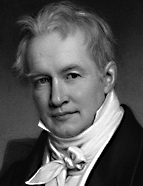

On 31 January 1840, the viscount commented: “And what shall I say of Mr. Humboldt’s latest work [Examen critique..., volume V]! The episodes, the notes, the digressions, the discussions in the text, in the notes, in the appendices, are in their thousands. And how do critics outside this field view this work? Let the scientific journals and academic reports say so, despite the many comments and observations that have been made about this vast work” (Viscount of Santarém, Correspondência do ... vol. VI, 1919, p. 77).
Alexander von Humboldt stood out for his gathering, collection and interpretation of scientific information, either locally or through his network of correspondents around the world. In this way, he built a multidisciplinary, innovative, original and solid body of work. One exception seems to have been the history of European discoveries, in which the gathering of material from writers and academics such as Estancelin and Avezac was carried out with a less rigorous and critical methodology. Reading sources in Castilian and French translations of Portuguese chronicles, he developed historical and geographical views that became a , a priori and undocumented theses about the Portuguese discoveries, namely the pseudo-priority of the Normans, the inhabitants of Dieppe and Jaime Ferrer over the proven priority of the Iberian peoples of Portugal. The reactive but respectful work of the Viscount of Santarém impressed the universal scholar Humboldt, which did not prevent the Prussian author from persisting in such views (for example, about the pseudo-voyages of Amerigo Vespucci). The Franco-German scientific and cultural world naturally adopted the readings of the genius of his time, much more than those of the Portuguese author, who died without his essential books from the 1840s and 1850s being reprinted. Thus, self-perpetuating mythologies are perpetuated, generation after generation, with no apparent possibility of refutation.
This work is financed by national funds through FCT - Foundation for Science and Technology, I.P, in the scope of the projects UIDB/04311/2020 and UIDP/04311/2020.
